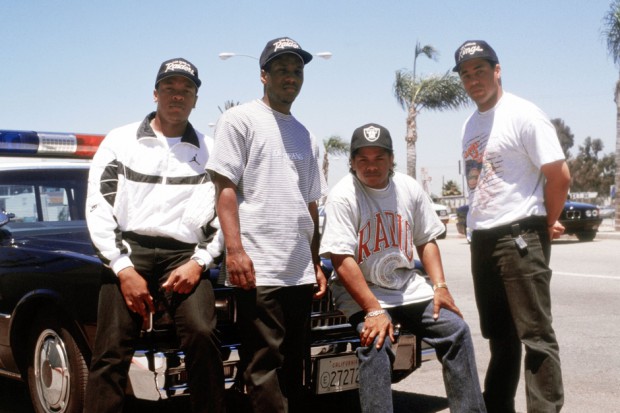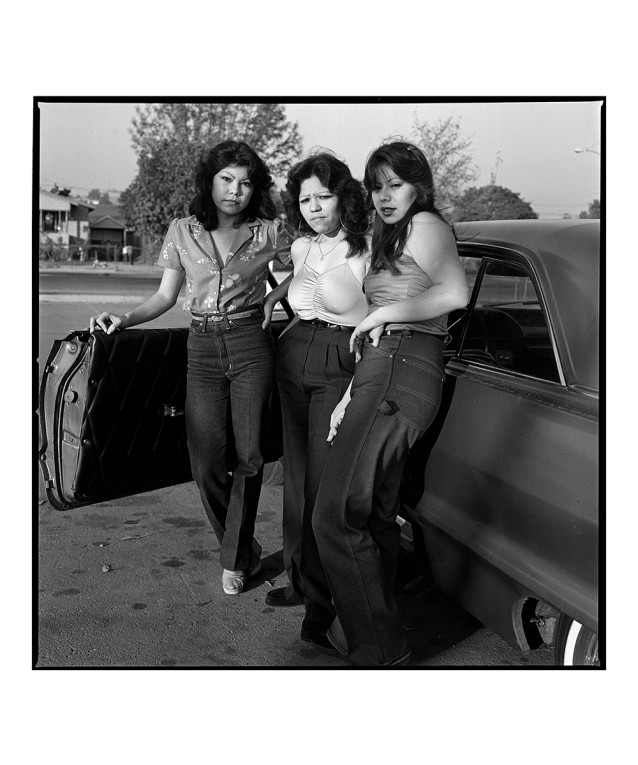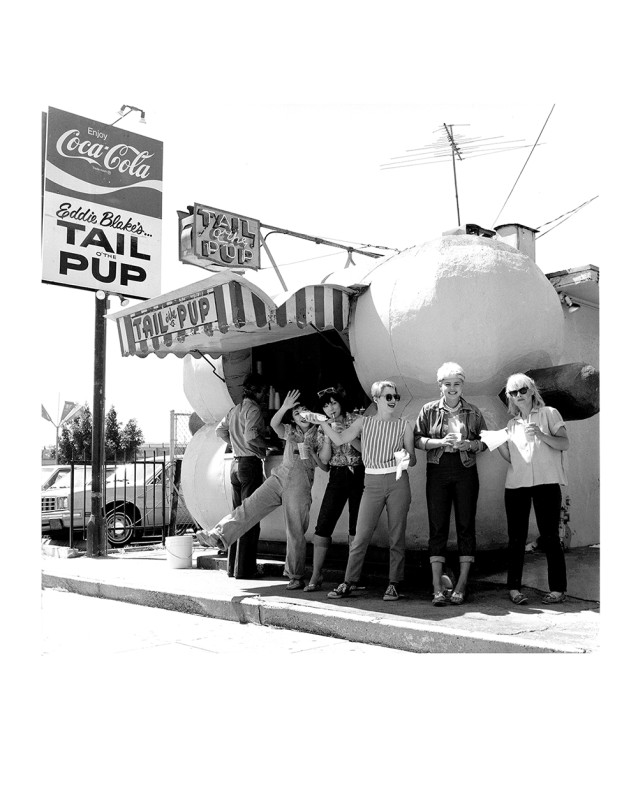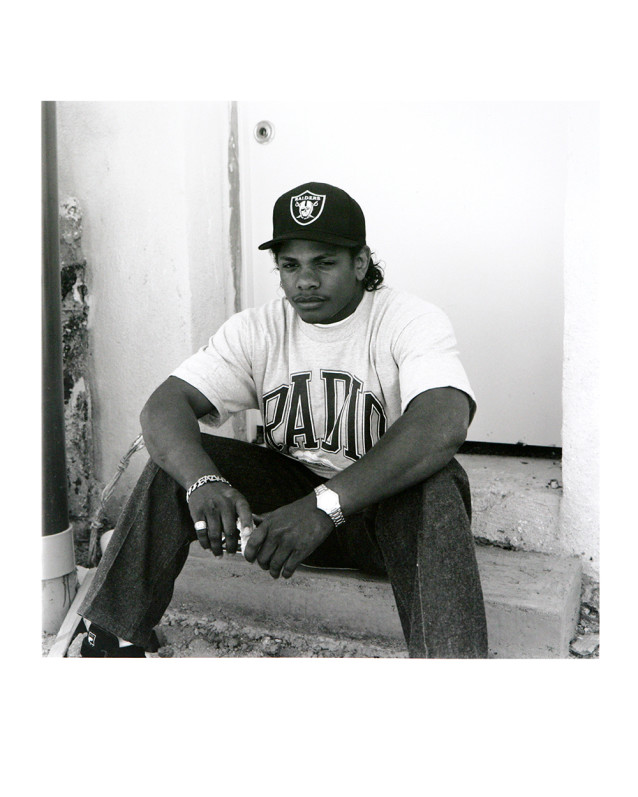Interview with Janette Beckman on her Rebel Cultures exhibition at HVW8 from LA Weekly as well as recent press from Hayabusa (Japan), Complex (US), Purple Magazine (France), Jay Z’s Life + Times and more below.

Dr. Dre, MC Ren, Eazy-E and DJ Yella of N.W.A. in 1990, near their studio in Torrance, California. Originally appeared in the book “Rap!” by Janette Beckman and Bill Adler.
Janette Beckman’s lens somehow always seems to always capture the intersection of gritty and cool. Born in London, England, Janette is a product of the ’70s punk movement. Like the music and lifestyle her art embodied, she soon crossed the ocean to New York, and has lived there since the top of the ’80s. Almost 35 years later, Janette has amassed portraits of rockers, rappers, painters, gangsters and more than a few would-be music moguls in the form of Rick Rubin, Dr. Dre and Russell Simmons. Regardless of who her subject is, Janette seems to find the honesty as well as the style in people. If the camera won’t show it, the jovial photographer’s anecdotes surely will. Beginning April 17th, select photos of Beckman’s are featured in HVW8 Art + Design Gallery (661 N. Spalding) in an exhibition called Rebel Cultures: Punks, Rap & Gangs, sponsored in part by Diamond Supply Co.
For the opening, Janette traveled back to L.A. 31 years after her first trip (prominently featured in the curation). Gallery goers included Curt Smith of Tears for Fears, Delicious Vinyl’s Rick Ross, and even three subjects that Beckman has bonded with since meeting them by chance a lifetime ago.
West Coast Sound: Much of your portrait work is often associated with New York. I’d like to talk about some of your L.A. photography. It’s in your book, The Breaks, and it’s prominently featured in this exhibit. This photo from 1983, “Gang Girls”; it’s such a moment in time. What prompted you to take that picture?

The “Riviera Girls,” then known as LA Happy Loca, LA Smiler Loca and LA Chrissy Loca, standing beside an early 1960s Chevrolet Impala in East Los Angeles. They reportedly attended Janette’s opening at HVW8.
Janette Beckman: In 1983, I was visiting a friend who managed The Go-Go’s, a seminal L.A. punk band. I just happened to pick up what I think was the L.A. Weekly, and read about this East L.A. gang, the El Hoyo MaraVilla. I loved the story so much, and there were no pictures. I just kind of got fascinated, so I got in touch with the writer and asked if he would introduce me to the gang.
He ended up driving me up there. It was this dusty park in East L.A., with that wall there with all the graffiti painted on it. I was there most of the summer and rented an old Ford LTD or something from Rent-A-Wreck, and every day, I would drive up. I went up there with a box of prints that I’d taken, of punks and mods and stuff in London. “These are the gangs of England, and I want pictures of you guys, and bring them back to the U.K. to show them.” They were totally cool with me. I just got fascinated with the whole lifestyle. They were all so nice and accepting of me. I guess word got around the neighborhood, and somebody told one of their friends, and those three girls turned up one day in that car to get their picture taken. The Riviera Bad Girls, that’s what they called themselves: Vicky, Norma and Vivian.
I just love the way that picture is taken – the whole style, the way they’ve got their eyebrows shaved, and they’ve all got such attitude. You’re right, it’s like a moment in time.
In 2011, Dashwood Books did a tiny little book of art imprints from my pictures from that series. Somehow it got a lot of Internet play, and the girls found me. I ended up sending them photos, and visiting them. It’s amazing, those three girls – which I took a picture of them [recently], they have done so well. The one in the middle is now working at the Homeboy Café, rehabilitating gang members. The other two … one was working for the district attorney’s office, I think, and the [last] has a job in human resources, and drives a Mercedes. They all have kids. They’re three [fashionable], beautiful women who have remained best friends and done so well after dealing with so much. They told me that 95% of the guys in my book were either killed or in jail.

The Go-Go’s outside the Tail Of The Pup in 1983. The novelty architecture landmark stood at the corner of La Cienega and Beverly from 1946 to 2005.
WCS: You mentioned The Go-Go’s. Their style iconography, especially as you portrayed them, is a kind of cool and grit that seems to be inspiring today’s artists and youth movements. How do you feel about that?
JB: I love the word “grit,” by the way. That’s something I really aspire to. The photo of The Go-Go’s, that’s outside of the Tail Of The Pup, which I think is now stored in some warehouse somewhere. Looking at Belinda [Carlisle] in those little Capri pants … it’s a bunch of girls having a hot dog, basically. You laugh. That epitomizes the young and fresh Go-Go’s. I love the historic aspect of it, 20 and 30 years later. I’m always amazed that people are still looking back.
WCS: There aren’t a ton of photoshoots of N.W.A. out there. You famously snapped the last four members in the last year of the group. They’re not all in black, and they are also leaning on an LAPD car. As the group is soon to be the subject of a biopic, what do you see looking at that photo today?
JB: When N.W.A. came out with “Fuck the Police,” that was a huge moment. Everybody knew that song. I know that it caused a lot of trouble for them. Right around that time I went to their studio, ’cause I was doing [Rap!: Portraits & Lyrics of a Generation of Black Rockers] with [Bill Adler] in 1990, actually, and I wanted to get some of the L.A. [artists]. I was the one that flagged down the police car. “I want to take a picture of this band,” I didn’t say who they were, and the cop was cool with it.
That shot literally took three minutes, and the cop went on his way. Then I went down an alley and took individual shots of each of them – one of [the Dr. Dre portraits] just ran in Esquire by the way. Eazy-E looked so moody and far away; we can conjecture what we want right now, considering he passed [away]. Doesn’t he kind of look like he’s thinking about something? He said to me, “I really like your accent. Would you mind coming in and reading something? We’re recording now. Maybe you can be on the album.” I go in there, read it, and [it is instructions] “How To Give The Perfect Blowjob” [which later appeared as “She Swallowed It”]. [Laughs] He wanted me to read it with my English accent. “You know what? I don’t think I’m going to do that right now.” Basically, I didn’t. I kind of regret it. With history, it’d be amazing to say, “I’m on [Niggaz4Life],” but I was in my feminist mode.

One of two photographs Janette Beckman took of Eric “Eazy-E” Wright outside of N.W.A.’s studio in 1990
WCS: How do you think the city of Los Angeles has changed since when you began shooting in it 31 years ago?
JB: It’s still very chill, there’s some great street-art and graffiti, which is nice. They tore down so many of the iconic things I cared to shoot: the motels, the neon of course, to make shopping malls. That’s kind of a shame. East L.A. is mostly the same though. They built a nicer park [in Hoyo MaraVilla]. In [the ’80s], there were punk clubs and a whole scene … obviously the cars [today] are not as cool either.
The Rebel Cultures: Punks, Rap & Gangs exhibit is open at HVW8 through May 18th.
More Press from –
Jay Z’s Life + Times
